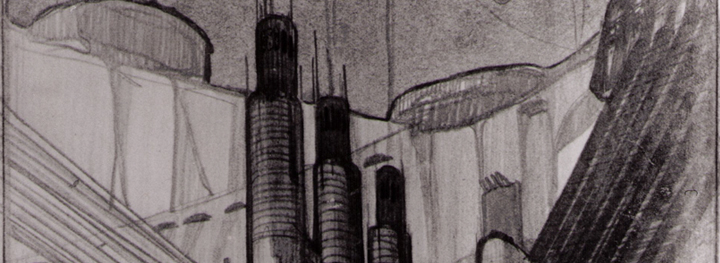Art & Art History
Antonio Sant’Elia: Drawings

Gallery 400
400 South Peoria Street, Chicago, IL 60607
Gallery 400 is pleased to present Antonio Sant’Elia: Drawings, an exhibition of drawings by the Italian Futurist artist and architect Antonio Sant’Elia (1886-1916). Sant’Elia ’s death during the first World War at the age of twenty-eight cut short an extraordinary career before he could realize his vision of a new architecture; his energetic drawings are his work. Although the truncation of his architectural career engendered many differing viewpoints, historians of modern art and architecture are unanimous in asserting his unique position among the Futurists. This traveling exhibition was the first major retrospective of a now legendary figure and the first time any of these drawings had been outside of Italy. The collection, containting over 70 works, hailing from the artist ’s estate, private collectors and the Museo Civico di Como, ranges from early sketches to drawings for the “New City,” his 1914 plan for large buildings with terraces, bridges and atriums.
The show included works that had been discovered in recent years and demonstrated the full extent of Sant’Elia ’s broad and philosophical approach to urban problems as well as his gift as an artist.
His well-known drawings of layered cities and towers with stepped profiles, published under the title “Futurist Cities” on the eve of World War I in Lacerba, are an accurate assessment of the transformation of cities that would take place in the 20th century.
Just as Picasso told Gertrude Stein that she would come to look like her portrait, so the modern city has come to look like the visionary drawings and plans by the young Italian architect.
Sant’Elia put his emphasis on the “new state of mind” brought about by rapid industrialization in Europe. Like the Viennese architect Adolph Loos, he advocated the use of new materials such as reinforced concrete, iron and glass, stripped of meaningless ornament. But his confidence in the role of new technology was not blind. Sant’Elia, as his elegant and inventive drawings attest, was an artist who was well aware of the radical shift in sensibility in the 20th century. He saw that:
“In the course of history changes of fashion are frequent and are determined by alterations of religious conviction and political disposition. But catalysts of deep change in the state of the environment are extremely rare, changes that unhinge and renew, such as the discovery of natural laws, the perfecting of mechanical means, the rational and scientific use of material.”
More than an architect with practical experience in engineering, Sant’Elia was an artist who saw as his mission the need to transform the world of things into a direct projection of the world or the spirit. His plans for the ideal city, while full of brilliant suggestions of a practical nature (suggestions that can be seen realized in such cities as Montreal, Haifa, Dallas, and Caracas) enter our culture as important milestones in the history of ideas.
Paul Goldberger, architecture critic for the New York Times, called this show, organized by Cooper Union in New York, “at once the most innocent and the most sophisticated architectural show around.” Goldberger, finding “uncanny resemblances” between the designs of Sant’Elia and Chicago’s Helmut Jahn, also underlined the contrast between Sant’Elia and Mies Van der Rohe, whose centennial was concurrently being celebrated. “Mies, … was in a sense the dry, fundamentalist preacher of the Modern movement; Sant’Elia was its flamboyant holy roller.”
The exhibition, curated by art critic Dore Ashton and noted Italian scholar Guido Ballo, was accompanied by a fully illustrated 150-page catalog featuring extensive essays by both curators. In addition to The Cooper Union, the show also appeared at Yale University Art Gallery and the Lowe Art Museum in Miami.